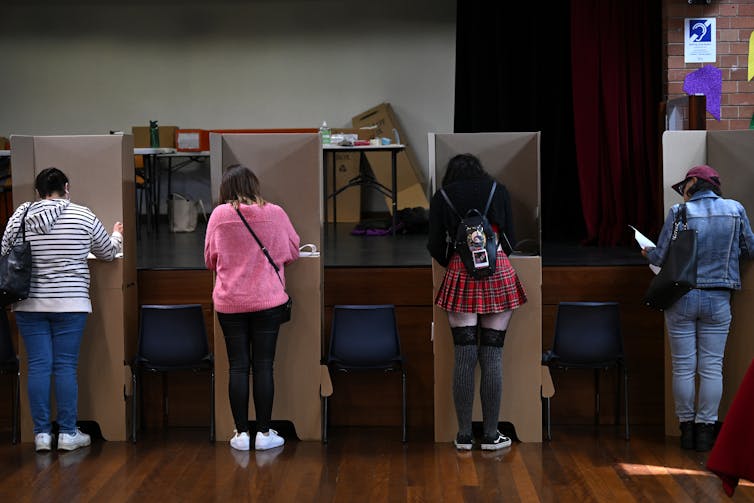
The 2022 federal election saw a significant move away from the two major parties, with a host of independent and Greens candidates taking seats from Labor and the Coalition.
Amid predictions about a “youthquake” before May 21, what role did young voters play in this radical electoral shift? And how important could they be by the next election?
The trend was there
Even before the election, researchers had noted major differences between younger and older voters.
Long-term voting patterns showed Labor was more likely to attract young voters. But surveys also showed how both the major parties have been losing their youth vote to the Greens.

As the Australian Election Study found after the 2019 election, 42% of voters under 24 did not vote for Labor or the Coalition. Of those aged 25 to 34, 35% did not vote for Labor or the Coalition. This compares to just 12% of those aged over 65.
We also know younger voters were more concerned about environmental issues and property prices than older voters. None of these were adequately addressed during the last term of parliament, which was marred by frightening bushfires, heat waves and floods, and saw inadequate action on climate change and rising intergenerational inequality.
Clear wins on May 21
So it is not surprising that electorates with the highest rate of voters under 30 saw unprecedented support for Greens in 2022. An analysis of AEC enrolment data shows seats with four of the top five highest proportions of young voters (18-29 year-olds) went to the Greens. This includes:
- Melbourne with a youth vote of 26.9% (Greens retain)
- Brisbane with a youth vote of 25.7% (Greens gain from the Liberal Party)
- Griffith with a youth vote of 24.7% (Greens gain from Labor)
- Ryan with a youth vote of 22.5% (Greens gain from the Liberal Party)
Also in the top five was the seat of Canberra with a youth vote of 23.1%. This was an easy Labor retain. However, here the Greens primary vote was almost 25% and the Greens, not the Liberal Party, were used for the two-party-preferred calculations.
There were also a relatively high rate of youth enrolment in key seats likes Kooyong (20.8%, independent gain from Liberals) and Fowler (19.5%, independent gain from Labor). There were other Liberal-turned-teal seats with a relatively lower proportion of youth voters (Curtin 17.7%, Wentworth 17.1%, Goldstein 16.3%, North Sydney 16.3% and Mackellar 15.6%). But it is important to acknowledge the women’s vote may have been a stronger driving force in these seats.
So, what does this mean electorally going forward?
The big debate about young voters
Leading up to the election there was a lot of speculation about young people’s voting behaviour. As other countries recorded a worrying decline in youth electoral participation, I argued young Australians are different.
Read more: What will young Australians do with their vote – are we about to see a 'youthquake'?
Still, there was concern the backdrop of COVID suffering, economic inequality, climate inaction and decaying trust in political leaders would culminate in youth political disengagement. Clearly, this did not happen.
Parties and politicians now are on notice
The election shows how the centre of gravity of Australian politics has shifted. The various swings away from the major parties revealed just how discerning voters can be. It also showed voters are likely to act based on policy concerns, rather than political allegiances.
The oldest millennial voters were 42 at this election, while first-time voters of 18 years of age included members of Generation Z. So, some of this can be attributed to generational replacement as the polls populate with more progressive, apartisan younger voters.

This trend is only going to increase. A basic analysis of current enrolments, plus expected future enrolments suggests that by the next election, millennial voters and younger (those under 45) will make up about 44% of the voting population. This is similar to this election – where they made up 43% – but significantly up from ten or 20 years ago. That means what we consider to be younger generations are replacing their older counterparts - and their more conservative values - over time in the electorate.
The 2022 election also sends a crucial political signal to the younger voters. The results show them the power of their actions to affect change in Australia’s democracy – and that the vote, in an aggregate sense, is an effective tool to do so. The 2022 federal election was one to restore young people’s hope and faith in the Australian democratic system.
Major parties need to acknowledge that younger voters do not like what they are offering, especially in response to climate change. If Labor is hoping to woo them back in 2025, it is interesting that “Minister for Youth” is not a cabinet position.
In the lead-up to their electoral success, the Greens worked hard in Brisbane – courting voters with young, personable candidates who went door-to-door to speak to voters directly. But they need to keep working. The Greens and teal victories were a virtue of issue-based voters, who will be watching whether these new MPs make change in Canberra.
Young voters in Australia can no longer be ignored.
Intifar Chowdhury does not work for, consult, own shares in or receive funding from any company or organisation that would benefit from this article, and has disclosed no relevant affiliations beyond their academic appointment.
This article was originally published on The Conversation. Read the original article.







